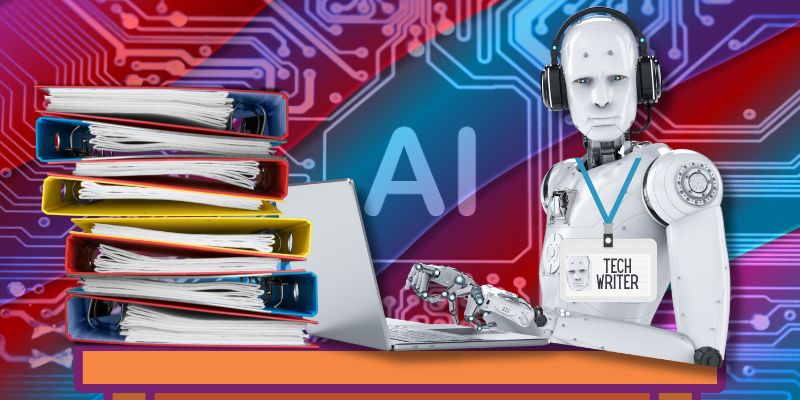AI in Technical Writing: What Does the Future Hold? (2025)

AI in Technical Writing is rapidly reshaping how specialists approach documentation and user-focused content. In this article, I explore how AI is transforming the industry, improving efficiency, and redefining how technical material is created, formatted, and optimized. While AI-powered solutions continue to advance, I believe the human element remains critical for maintaining accuracy, clarity, and contextual understanding. Skilled technical writers bring creative problem-solving and in-depth domain knowledge that technology alone cannot replicate.
Understanding Technical Writing
 Technical writing is a specialized field focused on creating documents that explain complex processes, products, or systems in a clear, concise manner. Common types of technical writing include:
Technical writing is a specialized field focused on creating documents that explain complex processes, products, or systems in a clear, concise manner. Common types of technical writing include:
- User Manuals
Guides to help users operate products efficiently. These manuals often come with step-by-step instructions, safety guidelines, and troubleshooting tips. - API Documentation
Detailed instructions on how different software components or services communicate. This documentation is critical for developers integrating third-party APIs, ensuring they understand endpoints, data formats, and authentication processes. - Standard Operating Procedures (SOPs)
Defined workflows or step-by-step procedures to ensure consistency and compliance within organizations. SOPs are particularly important in regulated industries like healthcare, finance, and manufacturing. - Technical Reports
Data-driven documents analyzing processes or systems. They can contain research findings, performance metrics, or feasibility studies, requiring precision and clarity to support business decisions. - Knowledge Base Articles
Centralized resources containing troubleshooting guides, frequently asked questions (FAQs), and product-related information. These articles are key to efficient customer support and self-service options.
The technical writing process requires clarity, precision, and accuracy. AI in Technical Writing is rapidly evolving to assist tech writers in streamlining content generation, improving image quality, and refining technical information.
Key Takeaways
- Technical Writing Remains Valuable: Even with AI’s rise, human insight and context are indispensable.
- AI Tools Enhance Efficiency: Automation of routine tasks frees writers for high-level thinking.
- Career Prospects Are Strong: Demand remains steady across major industries, with evolving skill requirements.
- Stay Adaptable: Embrace ongoing developments in AI in Technical Writing to remain competitive.
- Balance Is Key: Blend human intelligence with machine-driven productivity for the best results.
The Role of AI in Technical Writing
AI in Technical Writing aims to optimize various stages of the writing process, from initial content ideation to final proofreading. Modern AI systems, particularly those based on large language models, can rapidly generate drafts, suggest improvements in style, and even identify gaps or inconsistencies in technical details.
Key Functions of AI in Technical Writing Include:
- Draft Generation: AI can create initial drafts of user manuals, technical articles, or code documentation based on prompts or structured data.
- Style and Consistency Checks: Machine learning models analyze and correct grammar, tone, and brand voice, ensuring uniformity across documents. I use AI in document reviews to ensure it complies with the Chicago Manual of Style (CMOS) and Microsoft Writing Style Guide (formerly Microsoft Manual of Style). The results are typically excellent.
- Metadata and SEO Optimization: AI can recommend relevant keywords, headings, and meta descriptions to improve search engine visibility.
However, AI still faces challenges in:
- Contextual Understanding: AI often struggles to interpret nuanced, industry-specific jargon.
- Creative Problem-Solving: Humans excel at adapting content to unexpected scenarios or unique user needs, something AI isn’t always equipped to handle.
- Collaboration with Subject Matter Experts (SMEs): AI tools require high-quality data and direction from SMEs to ensure accuracy in specialized fields.
- Industry-Specific Terminology: Each sector has its own set of acronyms, standards, and best practices that might not be fully captured by AI models.
This aligns with Skyhive’s The AI Co-author: The Role of Technical Writing in Tech, Pharma, and Other Industries.
AI Capabilities in Technical Writing
Below are some of the most impactful AI-driven functionalities shaping technical communication:
- Natural Language Processing (NLP)
- Refines grammar, tone, and structure.
- Helps writers tailor content to diverse reading levels or brand guidelines.
- Automated Content Generation
- Produces draft content using large language models.
- Speeds up the creation of repetitive or template-based documents.
- Terminology Consistency
- Enforces uniform language across large documentation sets.
- Reduces errors and confusion by ensuring key terms are used consistently.
- AI-Powered Style Guides
- Implement branding and formatting best practices automatically.
- Provide real-time suggestions as writers compose text.
- Translation & Localization
- Tailor documentation for multiple languages and regional nuances.
- Streamlines the process of creating culturally relevant content.
- Schema Markup
- Improves search engine visibility through structured metadata.
- Helps users quickly find the most relevant sections of technical documents.
- High-Quality Images
- Enhances image quality for diagrams, flowcharts, and other technical assets.
- Uses AI upscaling or image enhancement to refine visual elements.
- Text-to-Image Models
- Generates AI-created images from detailed text prompts.
- Can quickly illustrate complex concepts or processes when stock images are unavailable or insufficient.
Human Writers vs. AI: A Comparative Analysis
Below is a quick overview that compares human writers to AI in Technical Writing:
| Aspect | Human Writers | AI Tools |
|---|---|---|
| Creativity & Originality | Can produce highly creative, context-specific content | Limited by training data and algorithms |
| Consistency & Speed | Prone to human error and slower output | Extremely fast and consistent in repetitive tasks |
| Adaptability | Can quickly learn and adapt to new or changing requirements | Relies on retraining or updates to the model’s data |
| Contextual Understanding | Deep understanding of nuances and user needs | May misinterpret specialized jargon or unusual contexts |
| Cost & Efficiency | Higher upfront costs (salary, time) | Lower incremental cost once tools are implemented |
| Quality Control | Able to verify data against real-world applications | Accuracy depends on the quality of the training data |
A hybrid approach often yields the best results: AI handles repetitive tasks and initial drafts, while human writers refine, verify, and adapt the content for real-world applications.
Best AI Tools for Technical Writing
Below is a comparison table for AI in Technical Writing, featuring top tools and their official links:
| AI Tool | Primary Use Case | Key Features | Official Link |
|---|---|---|---|
| ChatGPT | Content creation process | NLP-driven suggestions, context-based prompts, large language model | Visit ChatGPT |
| Grammarly | Grammar & style optimization | Advanced clarity & tone checks, real-time corrections | Visit Grammarly |
| Jasper AI | AI-driven blog posts | Custom text prompts, formatting options, marketing-focused | Visit Jasper |
| Copy.ai | Marketing & UX writing | AI-generated technical & marketing content, built-in templates | Visit Copy.ai |
| DocsBot AI | API documentation | Automated generation & updating of technical docs | Visit DocsBot AI |
| Writesonic | Technical writing automation | Quick, AI-generated drafts, built-in clarity checks | Visit Writesonic |
| DeepL | AI-powered translation tools | High-accuracy text conversion for multilingual content | Visit DeepL |
| MidJourney | AI-generated images | Advanced text-to-image generation, high-quality visual output | Visit MidJourney |
Advantages of AI in Technical Writing

Alll images in this blog post were generated using OpenAI’s DALL-e model.
Following are some of the advantages of AI in Technical Writing:
- Increased Efficiency
- Automates repetitive tasks like formatting and editing, freeing writers to focus on more complex issues.
- Cost-Effective Scaling
- Once deployed, AI can churn out large volumes of content at a relatively low incremental cost.
- Consistent Tone & Style
- Automated style guides ensure documents remain uniform in voice and presentation.
- Enhanced SEO
- AI-powered keyword research and schema markup recommendations can improve search engine rankings.
- Faster Localization
- Streamlined translation workflows allow businesses to quickly adapt documentation for global audiences.
- Better Resource Allocation
- With AI handling routine tasks, technical writers can delve into deeper analysis or more creative endeavors.
📚 Related: DALL-E vs MidJourney vs Stable Diffusion: Which AI is Best?
Disadvantages of AI in Technical Writing
- Risk of Inaccuracies
- AI-generated content can misunderstand industry-specific jargon or produce outdated information based on limited training data.
- Limited Contextual Understanding
- Complex or sensitive topics may suffer from oversimplification or misinterpretation by AI.
- Overreliance on Automation
- Without thorough human review, critical errors might go unnoticed, potentially damaging a product’s reputation.
- Ethical & Compliance Concerns
- High-stakes fields like healthcare or finance require stringent validation; AI’s factual errors could lead to legal complications.
- Loss of Human Insight
- AI lacks the emotional intelligence and hands-on experience that seasoned human writers provide, especially for nuanced topics.
Additional Insights: AI in Technical Writing
- AI in Technical Writing stands at the intersection of artificial intelligence and human intelligence, making it a powerful tool for modern documentation efforts.
- The rise of generative AI has propelled AI in Technical Writing to new heights, helping tech writers convert complex information into accessible formats.
- Moreover, AI in Technical Writing can accelerate the technical writing process by ensuring error-free content and streamlining the review cycle.
- In the context of user engagement, AI in Technical Writing significantly enhances user experience, catering to the needs of various skill levels through clearer explanations.
- Although AI in Technical Writing automates many aspects of documentation, human intelligence remains a crucial role for final checks and contextual accuracy.
- Organizations rely on AI in Technical Writing to break down complex information and transform it into user guides that align with the target audience’s knowledge base.
- Implementing AI in Technical Writing helps create error-free content swiftly, reducing manual editing time and improving overall quality.
- The synergy between tech writers and AI in Technical Writing also tackles technical jargon effectively, ensuring clarity across documents.
- As I witness the rise of generative AI, AI in Technical Writing will continue to shape best practices and play a crucial role in evolving documentation standards.
- My ongoing interest in AI in Technical Writing motivates me to stay updated on new tools and ai writing assistant features that can revolutionize the field.
Is Technical Writing a Good Career Choice?
Many factors make technical writing a promising career path:
- Steady Demand: Industries like software, finance, and healthcare need clear, accurate documentation.
- Transferable Skills: Research, writing, and communication apply to multiple roles.
- Competitive Salaries: Compensation often reflects specialized expertise.
- Remote Possibilities: Many technical writers work from home or anywhere with internet access.
In combination with AI in Technical Writing, these roles can become even more dynamic, blending human insight with machine efficiency. The ongoing need for accurate, well-structured content means technical writers remain vital to organizations worldwide.
You might be wondering if AI will replace technical writers ultimately? According to the Technical Writing HQ YouTube channel, we likely don’t have much to worry about for a long time.
Predictions on AI’s Impact on Jobs
- Enhanced Productivity: AI will continue automating repetitive tasks, allowing writers to focus on complex or creative aspects of documentation.
- Shifting Skill Sets: Writers may need to learn prompt engineering, AI tool configuration, and data validation.
- Collaboration Over Replacement: Rather than eliminating jobs, AI can serve as a complementary assistant, improving output quality and speed.
- Cross-Disciplinary Roles: Technical communicators might evolve into hybrid positions spanning writing, data science, and UX design.
- Ongoing Adaptation: The field could see frequent updates, meaning professionals who stay current with AI advancements will remain in high demand.
Technical Writing by the Numbers
Below is a table that highlights key statistics relevant to AI in Technical Writing, with links to three authoritative sites:
| Metric | Value or Range | Authority |
|---|---|---|
| Estimated Job Growth (2021–2031) | 6% growth | U.S. Bureau of Labor Statistics: Technical Writers |
| Average Annual Salary (U.S.) | $60,000–$80,000+ | Glassdoor: Technical Writer Salaries |
| Skill Demand Ranking | Top 25% among writing/communication roles | PayScale: Technical Writer Research |
These figures show that the discipline of technical writing, combined with AI in Technical Writing, continues to be both in demand and well-compensated.Examples & Actionable Tips for AI in Technical Writing
- Use AI to Speed Up Outlining: For instance, generating a quick outline in ChatGPT can reduce the time spent deciding structure.
- Pair AI Editing with Human Review: AI-based grammar checks are great, but always validate crucial details manually.
- Incorporate Visuals: Tools like MidJourney can help illustrate complex topics, especially if your audience learns better through graphics.
Common Mistakes in AI-Driven Technical Writing
- Skipping Validation: Relying solely on AI outputs can lead to errors. Validate key data points with SMEs and a resource like PlainLanguage.gov: Guidelines.
- Overlooking Tone: AI might produce content that’s too formal or informal for your target audience.
- Neglecting Updates: AI tools improve over time; ignoring new features or retraining can produce outdated content.
Dos and Don’ts for AI in Technical Writing
| Dos | Don’ts |
|---|---|
| Incorporate human feedback at key stages | Rely on AI alone for critical or regulated content |
| Use AI to handle repetitive formatting | Skip thorough QA and SME reviews |
| Stay updated on AI features and versions | Ignore legal or ethical guidelines in specialized fields |
FAQs
Q: How can AI assist me as a technical writer?
A: I rely on artificial intelligence as a powerful tool that helps me produce concise documentation, manage complex information, and maintain error-free content. Although ai algorithms handle routine tasks, my human intelligence remains crucial for technical expertise and user experience. I ensure relevant information reaches my target audience through thorough oversight. Additionally, I harness prompt engineering.
Q: What industries benefit most from AI in technical writing?
A: I see industries like software, healthcare, and finance benefit when they use ai technologies for the technical writing process. I integrate these ai writing tools to improve user guides, reduce technical jargon, and deliver a user-friendly interface. My approach ensures valuable tool usage for non-technical users, fostering successful knowledge transfer and also relevant information retention.
Q: Can AI improve SEO in technical writing?
A: I believe artificial intelligence significantly boosts search engines rankings by integrating prompt engineering and ai features in my documentation. I refine keywords, improve user experience, and deliver relevant information to specific audiences. However, my human intelligence preserves clarity, ensuring complex topics remain accessible and validated for a great tool outcome within the technical writing process.
Q: What risks come with AI-generated documentation?
A: I acknowledge that artificial intelligence may introduce intellectual property concerns, inaccurate technical information, or insufficient references for end users. Despite using ai writing tools, I must ensure error-free content through my human intelligence and technical expertise. I rely on new tools for quality of documentation, but I also maintain consistent oversight within the creative process.
Q: How do I choose the right AI tool for my technical writing needs?
A: I evaluate integration of ai with microsoft word, user-friendly interface, and support for the future of ai. Each software application varies in ai algorithms and new feature availability. My target audience determines if I need advanced prompt engineering or basic functionalities. Finally, I consider free plan options, focusing on benefits of ai and paradigm shift.
AI in Technical Writing: Conclusion
AI-driven solutions are revolutionizing the technical writing landscape, providing faster content generation, advanced editing capabilities, and valuable insights into user engagement. As these technologies continue to mature, they will offer even more sophisticated features—potentially handling much of the routine writing process with minimal human intervention.
Yet, the human element remains indispensable. Skilled technical writers offer contextual understanding, creative problem-solving, and collaboration with subject matter experts—dimensions that AI cannot replicate entirely. Businesses looking to leverage AI in technical writing should adopt a balanced approach: use AI for efficiency and scale, but maintain human oversight to ensure accuracy, consistency, and adaptability. This synergy will result in high-quality documentation that meets industry standards, fosters trust, and truly serves its end-users.
By embracing both AI-assisted tools and human expertise, organizations can stay at the forefront of technical writing, delivering content that is not only accurate and comprehensive but also engaging and reader-focused.
Read Next: Grammarly vs Grammarly Business
